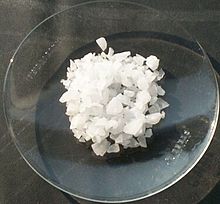
| |
| Names | |
|---|---|
| IUPAC name
Aluminium sulfate
| |
Other names
| |
| Identifiers | |
| |
3D model (JSmol)
|
|
| ChemSpider | |
| ECHA InfoCard | 100.030.110 |
| EC Number |
|
| E number | E520 (acidity regulators, ...) |
PubChem CID
|
|
| RTECS number |
|
| UNII |
|
CompTox Dashboard (EPA)
|
|
| |
| |
| Properties | |
| Al2(SO4)3 | |
| Molar mass | 342.15 g/mol (anhydrous) 666.44 g/mol (octadecahydrate) |
| Appearance | white crystalline solid hygroscopic |
| Density | 2.672 g/cm3 (anhydrous) 1.62 g/cm3 (octadecahydrate) |
| Melting point | 770 °C (1,420 °F; 1,040 K) (decomposes, anhydrous) 86.5 °C (octadecahydrate) |
| 31.2 g/100 mL (0 °C) 36.4 g/100 mL (20 °C) 89.0 g/100 mL (100 °C) | |
| Solubility | slightly soluble in alcohol, dilute mineral acids |
| Acidity (pKa) | 3.3–3.6 |
| −93.0×10−6 cm3/mol | |
Refractive index (nD)
|
1.47[1] |
| Structure | |
| monoclinic (hydrate) | |
| Thermochemistry | |
Std enthalpy of
formation (ΔfH⦵298) |
-3440 kJ/mol |
| Hazards | |
| NFPA 704 (fire diamond) | |
| NIOSH (US health exposure limits): | |
PEL (Permissible)
|
none[2] |
REL (Recommended)
|
2 mg/m3[2] |
IDLH (Immediate danger)
|
N.D.[2] |
| Related compounds | |
Other cations
|
Gallium sulfate Magnesium sulfate |
Related compounds
|
See Alum |
| Supplementary data page | |
| Aluminium sulfate (data page) | |
Except where otherwise noted, data are given for materials in their standard state (at 25 °C [77 °F], 100 kPa).
| |
Aluminium sulfate is a salt with the formula Al2(SO4)3. It is soluble in water and is mainly used as a coagulating agent (promoting particle collision by neutralizing charge) in the purification of drinking water[3][4] and wastewater treatment plants, and also in paper manufacturing.
The anhydrous form occurs naturally as a rare mineral millosevichite, found for example in volcanic environments and on burning coal-mining waste dumps. Aluminium sulfate is rarely, if ever, encountered as the anhydrous salt. It forms a number of different hydrates, of which the hexadecahydrate Al2(SO4)3·16H2O and octadecahydrate Al2(SO4)3·18H2O are the most common. The heptadecahydrate, whose formula can be written as [Al(H2O)6]2(SO4)3·5H2O, occurs naturally as the mineral alunogen.
Aluminium sulfate is sometimes called alum or papermaker's alum in certain industries. However, the name "alum" is more commonly and properly used for any double sulfate salt with the generic formula XAl(SO
4)
2·12H
2O, where X is a monovalent cation such as potassium or ammonium.[5]
- ^ Pradyot Patnaik. Handbook of Inorganic Chemicals. McGraw-Hill, 2002, ISBN 0-07-049439-8
- ^ a b c NIOSH Pocket Guide to Chemical Hazards. "#0024". National Institute for Occupational Safety and Health (NIOSH).
- ^ Global Health and Education Foundation (2007). "Conventional Coagulation-Flocculation-Sedimentation". Safe Drinking Water is Essential. National Academy of Sciences. Archived from the original on 2007-10-07. Retrieved 2007-12-01.
- ^ Kvech S, Edwards M (2002). "Solubility controls on aluminum in drinking water at relatively low and high pH". Water Research. 36 (17): 4356–4368. Bibcode:2002WatRe..36.4356K. doi:10.1016/S0043-1354(02)00137-9. PMID 12420940.
- ^ Austin, George T. (1984). Shreve's Chemical process industries (5th ed.). New York: McGraw-Hill. p. 357. ISBN 9780070571471. Archived from the original on 2014-01-03.
